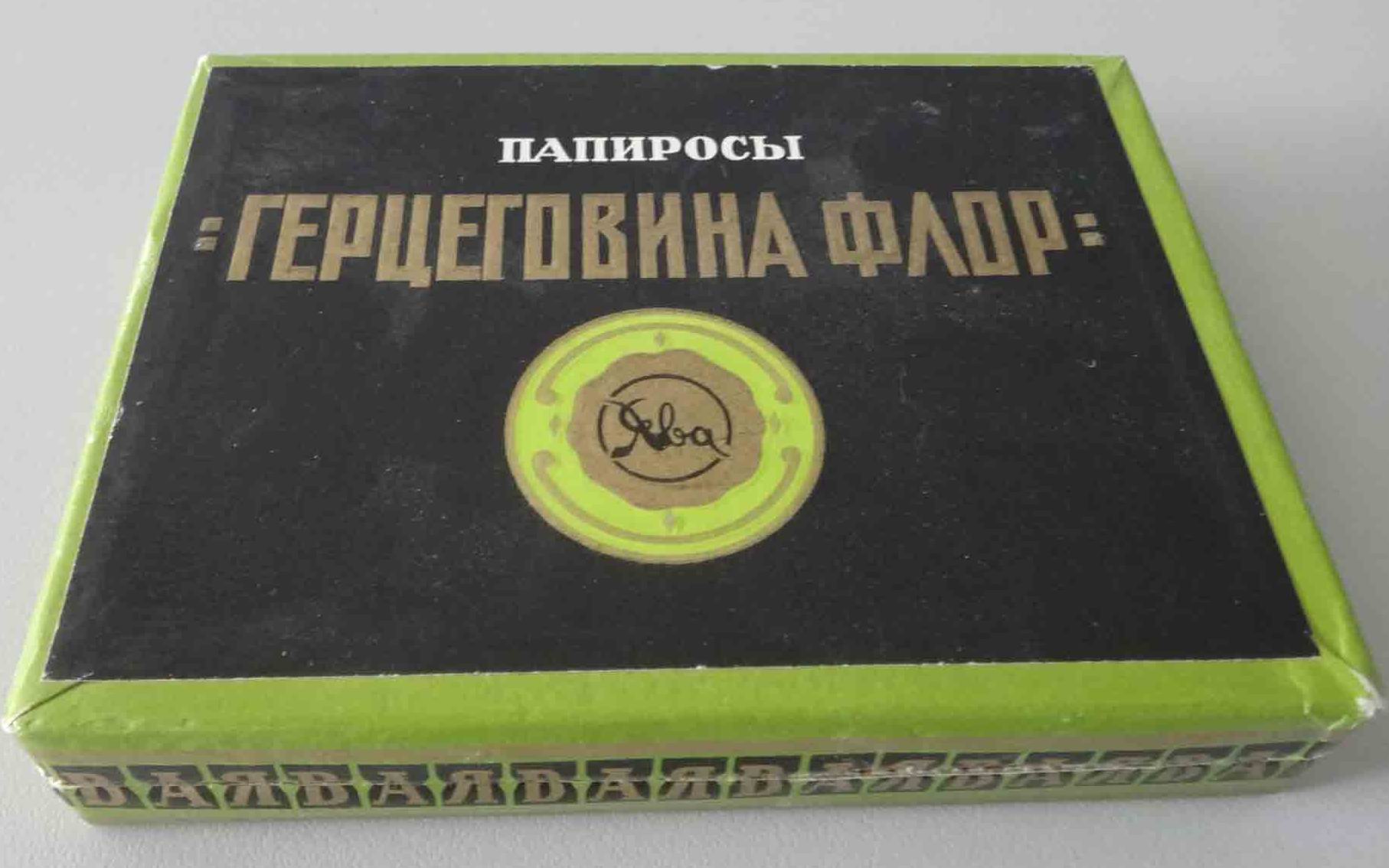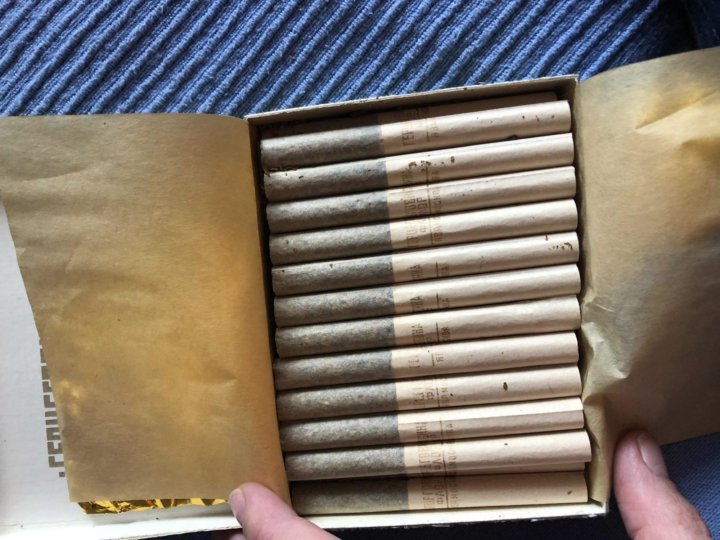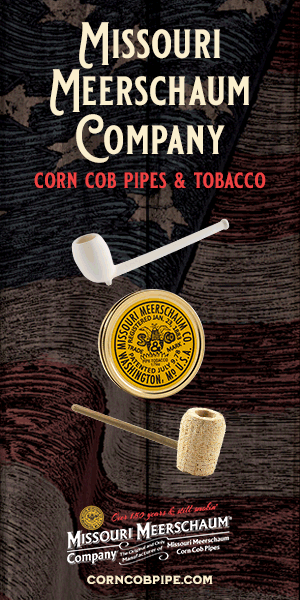"Škija" (pronounced Shkiya) is a type of Oriental blend brought from Java in Indonesia to the former Yugoslavian republics. "Ravnjak" means "plain." It is still grown in the former Yugoslav republics, where it is considered high grade toabcco, and people have been smoking it in pipes for generations. It is also in a cigarette called "Drina".
Škija Ravnjak is also known as "Herzegovina Flor." Herzegovina makes up part of southern Bosnia, and "Flor" means "flower." Herzegovina Flor leaf was brought in the time of the Russian Empire to Crimea. Some places in Russia and Ukraine still grow it, such as the Dagestan company "Tabak Yuga. You can also get the plant's seeds online.
In 1912, Samuel Gabai from Crimea began making a filterless cigarette (a "papirosa") brand called Herzegovina Flor that used the leaf variety. His factory in Moscow was renamed the "Java" factory, and continued to make the brand until around the early 1990's.


The ones in this photo on the right were made in the 1980's.
The blend used first, top grade tobacco leaf.
I read that Herzegovina Flor papirosi used a mix of Herz. Flor leaf plus another leaf variety, as well as a light plum flavored topping. The leaf was harvested or processed in a selective way to make the smoke softer.
Max Frunze smoked one in the video review below. He said that the smoke was soft, light, luxurious, not at all harsh on the throat like a lot of common papirosi. He said that its smell reminded him of a VA and had a floral aroma.
The Auto-translate function to convert it to English worked fine for me.
Frunze's "floral" description reminded me that premium Soviet pipe blends used geranium oil. I got a geranium-rose smell from 1974-83 Soviet Kapitanskiy, as well for that matter from Petersen's Standard Mixture and Germain's #7. His description also reminded me that Kapitanskiy has a VA or VA-Oriental smell for reviewers.
Herzegovina Flor papirosi can double as a pipe blend, since Stalin put it in his pipes. But I don't know how much better that would be for pipe smoking than using normal pipe tobacco. I found "Kapitanskiy" to be light and soft, but not any easier to inhale into the lungs than typical VA pipe blends.
Herzegovina Flor papirosi are occasionally sold on online antique auctions, and a common price range seems to me to be $40-200 per box of 25 papirosi.
I found a photo of a Herzegovina Flor cigarette packet made in 2004 by the Java factory when the factory was owned by British American Tobacco. But since then BAT has closed the factory.
In the late 1990's, the Morshansk factory briefly made cigarettes by the same name in yellow packets, and Intertabac in Moldova currently makes cigarettes in black-green packets by this name. But neither of these cigarettes is really like the high grade Java factory ones.
Škija Ravnjak is also known as "Herzegovina Flor." Herzegovina makes up part of southern Bosnia, and "Flor" means "flower." Herzegovina Flor leaf was brought in the time of the Russian Empire to Crimea. Some places in Russia and Ukraine still grow it, such as the Dagestan company "Tabak Yuga. You can also get the plant's seeds online.
In 1912, Samuel Gabai from Crimea began making a filterless cigarette (a "papirosa") brand called Herzegovina Flor that used the leaf variety. His factory in Moscow was renamed the "Java" factory, and continued to make the brand until around the early 1990's.


The ones in this photo on the right were made in the 1980's.
The blend used first, top grade tobacco leaf.
I read that Herzegovina Flor papirosi used a mix of Herz. Flor leaf plus another leaf variety, as well as a light plum flavored topping. The leaf was harvested or processed in a selective way to make the smoke softer.
Max Frunze smoked one in the video review below. He said that the smoke was soft, light, luxurious, not at all harsh on the throat like a lot of common papirosi. He said that its smell reminded him of a VA and had a floral aroma.
Frunze's "floral" description reminded me that premium Soviet pipe blends used geranium oil. I got a geranium-rose smell from 1974-83 Soviet Kapitanskiy, as well for that matter from Petersen's Standard Mixture and Germain's #7. His description also reminded me that Kapitanskiy has a VA or VA-Oriental smell for reviewers.
Herzegovina Flor papirosi can double as a pipe blend, since Stalin put it in his pipes. But I don't know how much better that would be for pipe smoking than using normal pipe tobacco. I found "Kapitanskiy" to be light and soft, but not any easier to inhale into the lungs than typical VA pipe blends.
Herzegovina Flor papirosi are occasionally sold on online antique auctions, and a common price range seems to me to be $40-200 per box of 25 papirosi.
I found a photo of a Herzegovina Flor cigarette packet made in 2004 by the Java factory when the factory was owned by British American Tobacco. But since then BAT has closed the factory.
In the late 1990's, the Morshansk factory briefly made cigarettes by the same name in yellow packets, and Intertabac in Moldova currently makes cigarettes in black-green packets by this name. But neither of these cigarettes is really like the high grade Java factory ones.







